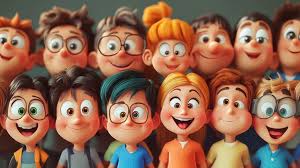The development of strong character and social-emotional skills remains one of the most important aspects of childhood education. A skilled teacher recognizes that these crucial life skills can be taught through many channels, including the thoughtful use of kids animated shows that demonstrate positive values through engaging stories and relatable characters.
Experienced teachers have discovered that many kids animated shows are specifically designed to address social-emotional learning objectives. From conflict resolution and empathy to perseverance and honesty, these programs present complex social situations in accessible ways that young viewers can understand and relate to their own experiences.
Emotional Literacy Through Character Experiences
One of the most valuable aspects of quality animated programming is its ability to make emotions visible and understandable to young viewers. When cartoon characters express feelings through exaggerated facial expressions, body language, and verbal expressions, children learn to recognize and name these emotional states. Teachers can pause shows at key moments to discuss how a character is feeling and why, helping students build their emotional vocabulary.
These emotional literacy skills transfer to real-life social interactions, where children can better recognize feelings in themselves and others. By discussing animated characters’ emotional journeys, teachers provide students with a safe, removed context to explore difficult feelings before they encounter similar situations in their own lives. This preparation builds emotional resilience and self-awareness.
Conflict Resolution Models
Most children’s animated shows feature conflicts and resolutions as central plot elements, providing excellent opportunities to discuss constructive problem-solving approaches. Teachers can highlight how characters work through disagreements, emphasizing cooperation, compromise, and communication rather than aggressive or avoidant tactics.
After viewing conflict scenarios, teachers can guide students to identify alternative solutions the characters might have tried, encouraging creative problem-solving and critical thinking about social situations. This analysis helps children develop a repertoire of strategies for handling real-life conflicts they encounter on the playground or in other social settings.
Cultural Values and Ethics
Animated shows often contain explicit or implicit moral lessons that reflect cultural values and ethical principles. Thoughtful educators can use these narratives to facilitate discussions about fairness, honesty, respect, responsibility, and other core values that form the foundation of positive character development.
By analyzing the consequences characters face for different choices, children develop an understanding of cause and effect in social contexts. Teachers can extend these lessons by asking students to connect animated scenarios to real-life situations they might encounter, helping them transfer ethical reasoning from the screen to their daily interactions.
Building Empathy Through Diverse Perspectives
Modern animated shows increasingly feature diverse characters with varied backgrounds, abilities, and perspectives. This representation provides valuable opportunities for teachers to nurture empathy and understanding across differences. When children identify with animated characters whose experiences differ from their own, they practice perspective-taking—a fundamental component of empathic development.
Teachers can enhance these benefits by asking questions that encourage perspective-taking: How do you think this character feels about what happened? Why might they see the situation differently than the other characters? What would you do if you were in their position? These discussions help children recognize and value multiple perspectives in social situations.
Promoting Prosocial Behaviors
Many educational animated shows explicitly model prosocial behaviors such as helping others, sharing, taking turns, and including peers in activities. Research indicates that children are more likely to adopt these behaviors after seeing them positively portrayed by characters they admire. Teachers can reinforce these messages by connecting animated examples to classroom expectations and recognizing when students demonstrate similar prosocial actions.
For maximum impact, teachers should explicitly bridge the gap between screen examples and real-life application. Simple phrases like “Remember how Daniel Tiger took deep breaths when he felt angry? Let’s try that when we feel upset in class” help children transfer strategies from their favorite shows to their own behavior management.
Supporting Family Engagement
Character education is most effective when reinforced across home and school environments. Teachers can engage families by sharing information about the animated shows used in class and suggesting ways parents might extend these lessons at home. Many educational programs offer parent resources that teachers can distribute to create consistency in how social-emotional skills are discussed and practiced.
When teachers and families use common language drawn from familiar animated shows, children receive consistent messaging about expected behaviors and values. This alignment strengthens the impact of character education efforts and creates valuable home-school connections.
Conclusion
While animated shows should never replace direct teaching of social-emotional skills through real interactions, they provide a valuable supplementary tool for character education. By thoughtfully selecting and discussing quality animated content, teachers can bring abstract concepts like empathy, honesty, and cooperation to life through engaging stories and memorable characters.
As with any educational tool, the impact of animated content depends largely on how teachers frame and extend the viewing experience. When teachers actively guide reflection and help children connect animated examples to their own experiences, these colorful shows become powerful vehicles for developing the character traits and social-emotional skills that will serve children throughout their lives.

